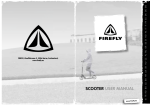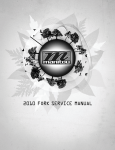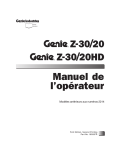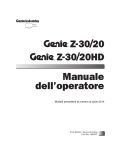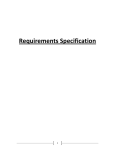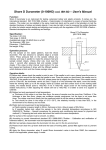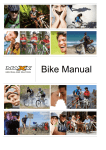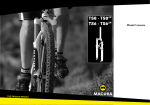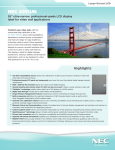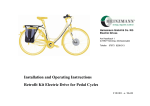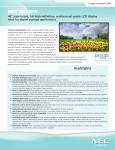Download English - Kickbike
Transcript
Kiitos, että valitsit Kickbike potkulaudan. That’s Finnish as our scooters and means: “Thank you, for buying Kickbike scooter.” You are reading Kickbike user manual. Please read parts: maintenance, warnings, warranty and tips well. You can follow this manual to assembly you Kickbike. Hope you enjoy riding Kickbike! Contents ➢ ➢ ➢ ➢ ➢ ➢ ➢ ➢ ➢ ➢ ➢ ➢ ➢ Handlebar installation Mudguard installation Wheels installation Pump tires Adjustment of the brakes Footboard height adjustment Kickstand adjustment Basket installation Suspension fork Maintenance Warnings Warranty Tips 2 3 4 4 5 6 7 7 7 7 7 7 7 Part list City G4 (Quite similar to Freeride, Sport G4, Cruise MAX 20, Race MAX 20/28) A. B. C. D. E. F. G. H. I. J. K. L. M. N. O. P. Q. R. S. T. U. V. W. X. Y. Z. Bell Handlebar Brake lever Handlebar stem Headset bearing Basket (only in CityG4) Headtube Front Brake Assembly Mudguard Frame Drinking bottle fixing screws Footboard Heel arch Rear Brake Assembly Quick release axle Hub Rear reflector Spoke Rim Tyre Valve Kickstand Remote lockout Disc (Suspension) fork Brake cables Cross MAX 20D/20HD (Quite similar to Cross MAX 20V, Cross 29er, FAT MAX) The frame number is written on the front part of the head tube, just below the Kickbike figure. We recommended you write it here. My Kickbike frame number is: ___________________________________________________ Kickbike owner’s manual - 1 Handlebar installation Freeride (Fig. 1), City G4 (Fig. 2) 1. 2. 3. Insert stem bolt into head tube. Tighten the screw from the stem bolt. (Freeride Fig. 1.2, City Fig. 2) Tighten clamp screws. (1.2) If you want you can first adjust angle of the handlebars. (Only in Freeride) Notice that “min insertion” mark has to be inside the head tube! Sport G4, Cross-models, FAT MAX, Cruise MAX 20, Race-models, (Fig. 3) 1. Connect handlebar into the stem. (3.1) 2. Tighten the screws 3. Loosen cap bolt. Don’t let front fork fall! 4. Lift the cap bolt and cap (3.2 - A) 5. Place stem, stem bolt and cap (A) to the steer tube in front fork (3.3) 6. Tighten cap bolt. Finger tight is enough. 7. Look that stem is straight relative to front wheel. Tighten clamp bolts. (3.3) Kickbike owner’s manual - 2 Mudguard installation Front City G4, Sport G4, FAT MAX (Fig. 4) 1. 2. 3. Place the mudguard Place and tighten the screw and washers. (4.1) Place and tighten the screws on both sides of the front fork. Cross, Freeride, Race plastic frame mudguard already assembled. (Fig. 5, A) Rear City G4, Sport G4, Freeride (Fig. 6, position B, D) Cross (Fig. 6, position B, C) Race MAX 20 (Fig. 6, position A, D) Cruise MAX, FAT MAX (Fig. 6, position A, C) 1. 2. Place and tighten the screw and washers. (Fig. 6.1) Place and tighten the screws on both sides of the frame. (Fig. 6) Race MAX 28 no rear mudguard standard (optional, Fig. 6, position C, A). note: depending on your typical ride conditions you may choose not to install the front mudguard, but we recommend rear mudguard if there’s any chance of rain. Kickbike owner’s manual - 3 Wheels installation Freeride, City G4, Sport G4, Cruise MAX, Cross MAX 20V, Race MAX 20 (Fig. 7 and 8) Race MAX 28 (Fig. 8, skip steps 1,2 by opening switch Fig. 11 A) Cross MAX 20D, Cross MAX 20HD, Cross 29er (Fig. 8, skip steps 1,2 by taking away plastic disc cover Fig. 7.2) note: Axles are different sizes in all models except FAT MAX and Race MAX 28. Longer axle is the front axle. note: Wheels are different sizes in all models except Race MAX 28. Bigger wheel is the front wheel. 1. 2. 3. 4. 5. 6. 7. 8. To open the brake, push the brake arm… (Fig. 7) ...and take brake cable out from the hole. (Fig. 7.1) Place wheel a. Front wheel (Fig. 8.1) b. Rear wheel (Fig. 8.2) City G4, Sport G4, Cross-models, Freeride, FAT MAX (position B) Race-models, Cruise MAX (position A) Place the quick release axle. See position and direction of springs. (Fig. 8) Tighten the nut of quick release. (Fig. 8) Close the lever of quick release. (Fig. 8) At correct tightness you need brisk force but never tools. Align the lever so that it’s not likely to catch your shoelaces. Push both brake arms… (Fig. 8) … and place brake cable back to it’s hole. (Fig. 8.3) Pump tires All (Fig. 9) 1. 2. 3. 4. Place pump to the valve Turn lock to up position Pump Unlock pump Recommended air pressures (bar/PSI) Freeride (3/45), City G4 (4/55), Sport G4 (5/ 75), Cross(3/45), FAT MAX (1/15), Cruise MAX 20 (3/45), Race (6/85) Kickbike owner’s manual - 4 Brakes adjustment V-brakes / Caliper-brakes Freeride, City G4, Sport G4, Cruise MAX 20, Cross MAX 20V, Race MAX 20 (Fig. 10) Race MAX 28 (Fig. 11, skip step 1 by checking that switch (A) is closed +) 1. 2. 3. 4. 5. 6. Use bolt (A) to roughly adjust brake cable if needed. Use bolts (B) to put brake pads (E) in line with rims (D). Test that brake pads (E) attach to rims (D) correctly (see Fig. 10.1) by using levers. Use screws (C) to balance distance equal from rim to both brake pads. In model Race MAX 28 center brake moving whole brake frame by hand. If you have small hands, use adjustment screw (Fig. 12 - A) to get brake levers closer to the handlebar. Use fine adjustment screw (Fig. 12 - B, Fig 11 - F) to get brake pads closer to rims if needed. Test that brake works. Disc brakes Cross MAX 20D, Cross MAX 20HD, Cross 29er (Fig. 13) 1. 2. 3. 4. 5. 6. 7. 8. Test if the brake is fine by rotating wheel. If you hear that disc touches to brake, continue to next steps. Loosen bolts (Fig. 13 - A) Loosen adjustment hex screw (C) all the way and close it until you hear 6 clicks (Only mechanical disc brake system) Use brake levers to center brake. Tighten bolts (A) while holding lever. Loosen adjustment screw (C) until you hear 4 clicks (Only mechanical disc brake system) Look that disc (D) is not touching the brake when brake pads are open. Test that brake works. Kickbike owner’s manual - 5 Footboard height adjustment All Kickbike models have an option to choose low or high ride position. Low position (Fig. 14 A) is easier to kick and in the high position (Fig. 14 B) the frame has more ground clearance. Changing footboard height requires some further adjustments! Follow instruction on this page to change position. Default position in models Race, Cruise MAX is low (A) and in Cross, Sport G4, City G4, Freeride, FAT MAX high (B) Change footboard height 1. 2. 3. 4. 5. Remove rear wheel (inverse phases page 4) Change rear mudguard position if needed. High position (Fig. 6, position B) and low position (Fig. 6, position A) In models Cross MAX 20D, Cross MAX 20HD, Cross 29er, FAT MAX adjust position of rear brake 3.1. Change brake holder to high position (Fig. 16 - F) or low position (Fig. 15 - E) and attach it to frame (G) with screws (H) 3.2. Install brake (D) to brake holder. Washers (B and C) are optional and you need to put more if brake (D) hits to the disc (Fig. 13 - B). Replace the wheel (see page 4) Adjust brakes (see page 5) Kickbike owner’s manual - 6 Kickstand adjustment Freeride, City G4, Sport G4, Cross-models, FAT MAX, Cruise MAX 20 (Fig. 17) 1. 2. 3. Loosen adjustment screw Adjust height of kickstand Tighten adjustment screw Basket installation City G4 (Fig. 18) 1. 2. 3. Place basket into it’s place Tighten bolts see order (18.1) Tighten bolts see order (18.2) Suspension fork Cross MAX 20V , Cross MAX 20D, Cross MAX 20HD (Fig. 19) You can lock the suspension fork if needed. Cross MAX 20V lock suspension from switch (Fig. 19, A) and Cross MAX 20D, Cross MAX 20HD from remote switch (Fig. 19.1, A) in handlebar. The suspension preload adjustment switch (B) can make suspension harder or softer. Maintenance Even though the Kickbike is mostly a maintenance free transportation, it is recommended to perform a thorough inspection for loose bolts and spokes after first few hours of riding and also check the tightness of the screws and bolts of your Kickbike once in awhile. Also make sure that all the parts are in good condition. We recommend to take your Kickbike at least once in a year to an expert to get maintained. Warnings Shoelaces We recommend that you tie the shoelaces short and tuck the ends under laces to prevent them from catching brakes, quick release levers or other Kickbike parts while kicking. Curbs The Kickbike footboard is low because it makes kicking easier. It will touch high curbs and speed bumps. Ride safe and slow initially, to get familiar to what kind of obstacles are rideable. If you are not sure whether the footboard will clear a bump, walk it over. Helmet Remember to always use a helmet that fits you well and is an approved bicycle safety helmet. Keep hands in handlebar Do not attempt to ride one handed. Use your leg instead if you need to signal a turn. Warranty We want to make sure that you are happy with our product. The Kickbike Worldwide warranty is 2 years for the frame and one year for other parts. Warranty does not include the normal wear and tear of brake pads, brake cables and tyres. The warranty does not cover problems, which are caused by the lack of maintenance by the user, improper usage of other than standard spare parts for the Kickbike, incorrect methods of maintenance or damages which are caused by normal usage of the Kickbike. The warranty does not cover small unnecessary damages where the strength and usefulness of the Kickbike is not affected. These damages include such as slight uneven paint/varnish/chrome coverage that are caused by the changing weather or/and the normal usage of the Kickbike. The warranty does not cover damages that have been caused by improper usage of the Kickbike, like jumping. Tips Take long kicks, relax and roll between kicks standing straight Kick with toes only, heel does not touch the ground Learn to switch kicking foot every 4-10 kicks While riding Kickbike is quite ok in any outfit, we do not recommend high heels or clothing that may catch moving parts. For sportive rides, what’s good for running is good for kicking. See tips for kicking at kickbike.com Kickbike owner’s manual - 7 Kickbike owner’s manual - 8








